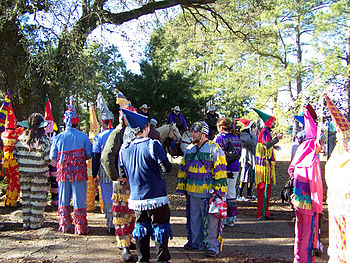This articleneeds additional citations forverification.(October 2008) |
Acapuchonis acone-shapedceremonial hat worn during theMardi Grascelebration in theCajunareas of southernLouisiana,known as theCourir de Mardi Gras.[1]The rural celebration is based on early begging rituals, similar to those still celebrated bymummers,wassailersand celebrants ofHalloween.As Mardi Gras is the celebration of the final day beforeLent,celebrants drink and eat heavily, but dress in costume, ostensibly to protect their identities.

Many of the traditional costumes are derivatives of the costumes worn in early ruralFranceduring the same celebration. The costumes directly mock the nobility, the clergy and the educated; celebrants wearmiterhats,mortarboardsand capuchons, which were initially designed to mock thetall pointy hatsworn by noble women.
These hats are still worn, primarily by men. The name "capuchon" comes from the same root word, "cappa" in Latin, meaning a cape or hood, that gives us "cap", "cape", "cope", "chapeau" in French,Capuchin monkeys,Capuchin friars,cappuccinosandbaseball caps.Chaperon (headgear)describes the development of the word. The hats are vibrantly decorated to match (or intentionally mis-match) the colorful Mardi Gras costumes that they accompany. They are often worn with a mask.
The capuchons worn by Mardi Gras celebrants are unrelated to the pointed hoods worn by theKu Klux Klan,and predate the hoods by several hundred years.
See also
editReferences
edit- ^Valdman, Albert; Rottet, Kevin;Ancelet, Barry;Klingler, Thomas; LaFleur, Amanda; Lindner, Tamara; Picone, Michael; Ryon, Dominique, eds. (November 12, 2009).Dictionary of Louisiana French: As Spoken in Cajun, Creole, and American Indian Communities(1 ed.). University Press of Mississippi. p. 107.ISBN978-1-60473-403-4.